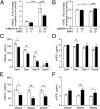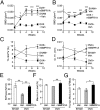A soluble bone morphogenetic protein type IA receptor increases bone mass and bone strength
- PMID: 22761317
- PMCID: PMC3409793
- DOI: 10.1073/pnas.1204929109
A soluble bone morphogenetic protein type IA receptor increases bone mass and bone strength
Abstract
Diseases such as osteoporosis are associated with reduced bone mass. Therapies to prevent bone loss exist, but there are few that stimulate bone formation and restore bone mass. Bone morphogenetic proteins (BMPs) are members of the TGFβ superfamily, which act as pleiotropic regulators of skeletal organogenesis and bone homeostasis. Ablation of the BMPR1A receptor in osteoblasts increases bone mass, suggesting that inhibition of BMPR1A signaling may have therapeutic benefit. The aim of this study was to determine the skeletal effects of systemic administration of a soluble BMPR1A fusion protein (mBMPR1A-mFc) in vivo. mBMPR1A-mFc was shown to bind BMP2/4 specifically and with high affinity and prevent downstream signaling. mBMPR1A-mFc treatment of immature and mature mice increased bone mineral density, cortical thickness, trabecular bone volume, thickness and number, and decreased trabecular separation. The increase in bone mass was due to an early increase in osteoblast number and bone formation rate, mediated by a suppression of Dickkopf-1 expression. This was followed by a decrease in osteoclast number and eroded surface, which was associated with a decrease in receptor activator of NF-κB ligand (RANKL) production, an increase in osteoprotegerin expression, and a decrease in serum tartrate-resistant acid phosphatase (TRAP5b) concentration. mBMPR1A treatment also increased bone mass and strength in mice with bone loss due to estrogen deficiency. In conclusion, mBMPR1A-mFc stimulates osteoblastic bone formation and decreases bone resorption, which leads to an increase in bone mass, and offers a promising unique alternative for the treatment of bone-related disorders.
Conflict of interest statement
Conflict of interest statement: N.S., M.C.-B., D.S., Y.K., K.L., K.W.U., J.U., R.K., E.P., A.G., J.S., R.S.P. are employees of Acceleron Pharma. P.I.C., M.L.B., and E.C. have received research funding from Acceleron Pharma.
Figures







Similar articles
-
A soluble bone morphogenetic protein type 1A receptor fusion protein treatment prevents glucocorticoid-Induced bone loss in mice.Am J Transl Res. 2019 Jul 15;11(7):4232-4247. eCollection 2019. Am J Transl Res. 2019. PMID: 31396331 Free PMC article.
-
Treatment With a Soluble Bone Morphogenetic Protein Type 1A Receptor (BMPR1A) Fusion Protein Increases Bone Mass and Bone Formation in Mice Subjected to Hindlimb Unloading.JBMR Plus. 2017 Oct 9;1(2):66-72. doi: 10.1002/jbm4.10012. eCollection 2017 Oct. JBMR Plus. 2017. PMID: 30283882 Free PMC article.
-
Targeted disruption of BMP signaling through type IA receptor (BMPR1A) in osteocyte suppresses SOST and RANKL, leading to dramatic increase in bone mass, bone mineral density and mechanical strength.Bone. 2016 Oct;91:53-63. doi: 10.1016/j.bone.2016.07.002. Epub 2016 Jul 8. Bone. 2016. PMID: 27402532
-
Bone morphogenetic proteins.Growth Factors. 2004 Dec;22(4):233-41. doi: 10.1080/08977190412331279890. Growth Factors. 2004. PMID: 15621726 Review.
-
The role of BMPs in bone anabolism and their potential targets SOST and DKK1.Curr Mol Pharmacol. 2012 Jun;5(2):153-63. doi: 10.2174/1874467211205020153. Curr Mol Pharmacol. 2012. PMID: 21787290 Review.
Cited by
-
The hepcidin regulator erythroferrone is a new member of the erythropoiesis-iron-bone circuitry.Elife. 2021 May 18;10:e68217. doi: 10.7554/eLife.68217. Elife. 2021. PMID: 34002695 Free PMC article.
-
Treatment with a BMP receptor blocker increases bone mass in mice.Bonekey Rep. 2012 Aug 29;1:179. doi: 10.1038/bonekey.2012.179. eCollection 2012. Bonekey Rep. 2012. PMID: 23986820 Free PMC article. No abstract available.
-
Novel Ti6Al4V Surface Treatment for Subperiosteal Dental Implants: Evaluation of Osteoblast-like Cell Proliferation and Osteogenic Response.Materials (Basel). 2025 Mar 11;18(6):1234. doi: 10.3390/ma18061234. Materials (Basel). 2025. PMID: 40141517 Free PMC article.
-
Bone Morphogenetic Protein 4 Gene Therapy in Mice Inhibits Myeloma Tumor Growth, But Has a Negative Impact on Bone.JBMR Plus. 2019 Nov 22;4(1):e10247. doi: 10.1002/jbm4.10247. eCollection 2020 Jan. JBMR Plus. 2019. PMID: 31956851 Free PMC article.
-
Smad2/3 Activation Regulates Smad1/5/8 Signaling via a Negative Feedback Loop to Inhibit 3T3-L1 Adipogenesis.Int J Mol Sci. 2021 Aug 6;22(16):8472. doi: 10.3390/ijms22168472. Int J Mol Sci. 2021. PMID: 34445177 Free PMC article.
References
-
- Wozney JM. Bone morphogenetic proteins. Prog Growth Factor Res. 1989;1:267–280. - PubMed
-
- Massagué J. Receptors for the TGF-beta family. Cell. 1992;69:1067–1070. - PubMed
-
- Keller S, Nickel J, Zhang JL, Sebald W, Mueller TD. Molecular recognition of BMP-2 and BMP receptor IA. Nat Struct Mol Biol. 2004;11:481–488. - PubMed
-
- Hatta T, et al. Identification of the ligand-binding site of the BMP type IA receptor for BMP-4. Biopolymers. 2000;55:399–406. - PubMed
-
- Chen D, Zhao M, Mundy GR. Bone morphogenetic proteins. Growth Factors. 2004;22:233–241. - PubMed
MeSH terms
Substances
LinkOut - more resources
Full Text Sources
Molecular Biology Databases

